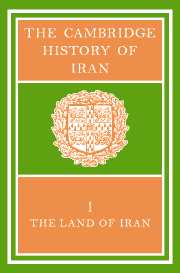Crossref Citations
This Book has been
cited by the following publications. This list is generated based on data provided by Crossref.
Gulick, John
and
Gulick, Margaret E.
1973.
VARIETIES OF DOMESTIC SOCIAL ORGANIZATION IN THE IRANIAN CITY OF ISFAHAN*.
Annals of the New York Academy of Sciences,
Vol. 220,
Issue. 6,
p.
441.
Kirk, R. L.
Keats, Bronya
Blake, N. M.
McDermid, E. M.
Ala, F.
Karimi, M.
Nickbin, B.
Shabazi, H.
and
Kmet, J.
1977.
Genes and people in the caspian littoral: A population genetic study in northern Iran.
American Journal of Physical Anthropology,
Vol. 46,
Issue. 3,
p.
377.
Snead, Rodman E.
1980.
World Atlas of Geomorphic Features.
p.
47.
Olson, Gerald W.
1984.
Field Guide to Soils and the Environment Applications of Soil Surveys.
p.
182.
Gershevitch, I.
1985.
The Cambridge History of Iran.
Araghi, Farshad A.
1987.
Agrarian class structure and obstacles to capitalist development in Iran.
Journal of Contemporary Asia,
Vol. 17,
Issue. 3,
p.
293.
Mir-Hosseini, Ziba
1987.
Some Aspects of Changing Economy in Rural Iran: The Case of Kalardasht, a District in the Caspian Provinces.
International Journal of Middle East Studies,
Vol. 19,
Issue. 4,
p.
393.
Karshenas, Massoud
1990.
Oil income, industrialisation bias, and the agricultural squeeze hypothesis: New evidence on the experience of Iran.
Journal of Peasant Studies,
Vol. 17,
Issue. 2,
p.
245.
Cameron, Averil
Ward-Perkins, Bryan
and
Whitby, Michael
2001.
The Cambridge Ancient History.
Rubin, Ze’ev
2001.
The Cambridge Ancient History.
p.
638.
Mojtahed-Zadeh, Pirouz
and
Hafeznia, Mohammad Reza
2003.
Perspectives on the Caspian Sea Dilemma: An Iranian Construct.
Eurasian Geography and Economics,
Vol. 44,
Issue. 8,
p.
607.
Bonine, Michael
2003.
Iran: The Pivotal State of Southwest Asia.
Eurasian Geography and Economics,
Vol. 44,
Issue. 1,
p.
1.
Clawson, Patrick
and
Rubin, Michael
2005.
Eternal Iran.
p.
5.
Chaverdi, Alireza Askari
Petrie, Cameron A.
and
Taylor, Helen
2008.
Early Villages on the Persian Gulf Littoral: Revisiting Tol-e Pir and the Galehdār Valley.
Iran,
Vol. 46,
Issue. 1,
p.
21.
Makhdoum, M.F.
2008.
Management of protected areas and conservation of biodiversity in Iran.
International Journal of Environmental Studies,
Vol. 65,
Issue. 4,
p.
563.
Jomehpour, Mahmoud
2009.
Qanat irrigation systems as important and ingenious agricultural heritage: case study of the qanats of Kashan, Iran.
International Journal of Environmental Studies,
Vol. 66,
Issue. 3,
p.
297.
Shepard, Jonathan
2009.
The Cambridge History of the Byzantine Empire c.500–1492.
Potter, Lawrence G.
2009.
The Persian Gulf in History.
p.
1.
Rigot, Jean-Baptiste
2010.
Dynamique de la rivière Poulvar et morphogenèse de la plaine de Tang-i Bulaghi (Fars, Iran) à l’Holocène. Premiers résultats.
Géomorphologie : relief, processus, environnement,
Vol. 16,
Issue. 1,
p.
57.
Haldon, John
2010.
The New Cambridge History of Islam.
p.
17.





